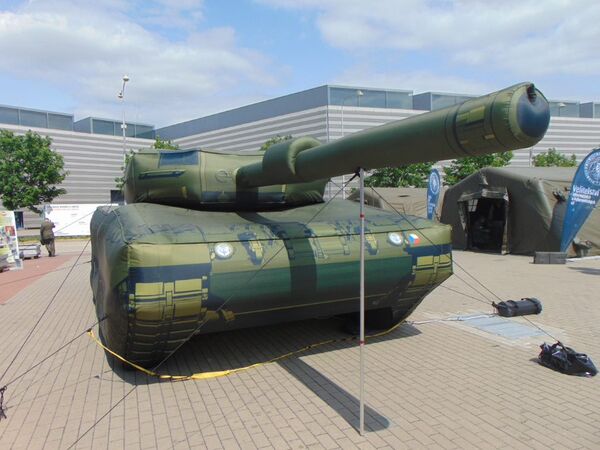
Inflatech displayed an inflatable Leopard 2A4 tank decoy system at IDET 2023. (Janes/Nicholas Fiorenza)
Inflatable Leopard 2A4 tank decoys are being supplied to Ukraine, Janes learnt at the International Defence and Security Technology Fair (IDET) 2023 held in Brno, Czech Republic, from 24 to 26 May. At the show, Czech-based company Inflatech displayed Leopard 2A4 and Czech STARKOM communication jammer inflatable decoys.
The decoys are designed to deceive and mislead an enemy by simulating objects and for use in electronic warfare training. The Leopard 2A4 decoy weighs 44 kg and the STARKOM decoy 35.2 kg. Their optical granularity is 0.2 m, thermal granularity is 0.6 m, and electronic granularity is 4 m, according to Inflatech. The company claims that they appear to an RQ-20 unmanned aerial vehicle as a real object from approximately 1,500 m.
The decoys can be inflated by a 150 ccm four-stroke petrol or diesel engine and take two people 10 minutes to deploy or pack. It is stable in winds up to 15 m/s, according to Inflatech.
The company avoids using metal or plastic structures to give a decoy the right shape, instead engineering the internal structure to reduce weight and improve the infrared signature, using hot air and the decoy's structure to manage hot air. Flexible radio reflectors and special radio reflective film are used to deceive enemy radars.
In addition to deceiving an enemy, inflatable decoys are used for training, for example in the air-to-ground attack by NATO in Sardinia.
Inflatech offers decoys of dozens of systems, including tanks, artillery, surface-to-surface missiles, air-defence systems, and combat aircraft.
Looking to read the full article?
Gain unlimited access to Janes news and more...
